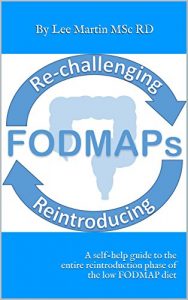It is time to strip away the mystery surrounding the reintroduction phase of the low FODMAP diet. This book brings clarity to a topic where knowledge, experience, information and skills are lacking. The book is written by a registered dietitian who has personally completed the diet and recently worked at King's College London researching the evidence behind the low FODMAP diet.
The book will provide a structured re-challenging protocol to follow and expose the two main methods you can use to re-challenge individual FODMAPs. A set of tables are provided which detail the foods containing individual FODMAPs to be re-challenged, along with the appropriate portion sizes to consume. Explanations of FODMAP tolerance levels and FODMAP thresholds will help you understand your results.
The second section of the book outlines how you can attempt to reintroduce FODMAPs back into your diet based on the results you obtain from your re-challenges. A further set of tables detailing foods that contain more than one type of FODMAP are included for reference. Following the process of re-challenging and reintroducing FODMAPs will lead to you following a modified low FODMAP diet in the long term.
At the end of the book is an extensive Frequently Asked Questions section with many valuable answers to common problems encountered from the reintroduction phase.
The reintroduction phase is most important part but also the most difficult part of the low FODMAP diet. To help manage your IBS symptoms and quality of life in the long term it is vital to complete the reintroduction phase. The ultimate aim is to self-manage a long term modified low FODMAP diet, consuming high FODMAP foods to personal tolerance without triggering IBS symptoms.
The book will provide a structured re-challenging protocol to follow and expose the two main methods you can use to re-challenge individual FODMAPs. A set of tables are provided which detail the foods containing individual FODMAPs to be re-challenged, along with the appropriate portion sizes to consume. Explanations of FODMAP tolerance levels and FODMAP thresholds will help you understand your results.
The second section of the book outlines how you can attempt to reintroduce FODMAPs back into your diet based on the results you obtain from your re-challenges. A further set of tables detailing foods that contain more than one type of FODMAP are included for reference. Following the process of re-challenging and reintroducing FODMAPs will lead to you following a modified low FODMAP diet in the long term.
At the end of the book is an extensive Frequently Asked Questions section with many valuable answers to common problems encountered from the reintroduction phase.
The reintroduction phase is most important part but also the most difficult part of the low FODMAP diet. To help manage your IBS symptoms and quality of life in the long term it is vital to complete the reintroduction phase. The ultimate aim is to self-manage a long term modified low FODMAP diet, consuming high FODMAP foods to personal tolerance without triggering IBS symptoms.






